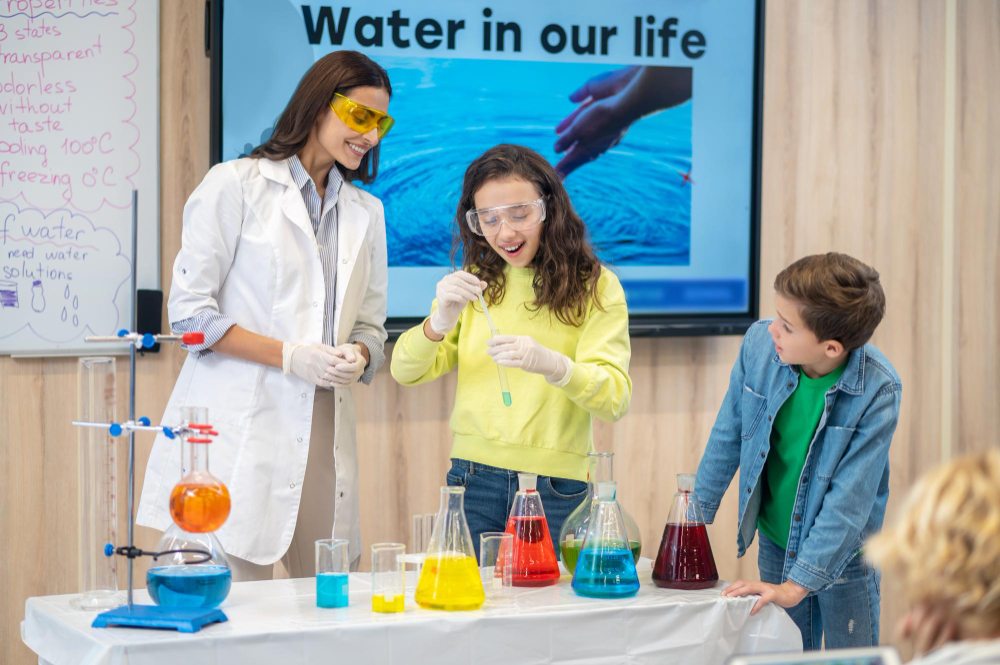Science is all around us, from the way a bouncy ball springs to the fascinating world of tiny insects. Yet, for many children, science can seem like a complex and distant subject. But what if we could transform learning into an exciting adventure that ignites a lifelong love for science?
This guide delves into the key ingredients for creating engaging science workshops for kids that spark curiosity and make science come alive for kids of all ages.
Ingredients for Success:
- Age-Appropriate Activities: Cater your workshop activities to the developmental level of your audience. Preschoolers thrive on hands-on exploration and play, while older children can handle more abstract concepts and complex experiments.
- Hands-On Learning: Move beyond textbooks and lectures. Engage children through practical activities that allow them to see, touch, and experiment with scientific concepts. This kinesthetic learning approach solidifies understanding and fosters a sense of wonder as they discover the “why” and “how” behind everyday phenomena.
- Interactive Experiments: Let curiosity be the driving force! Design experiments that encourage children to ask questions, make predictions, and test them out. This fosters critical thinking and problem-solving skills while making science workshops for kids relatable and fun. For example, instead of simply telling children about the properties of air, conduct an experiment where they build and race paper airplanes, observing how wing design affects flight.
- Storytelling and Showmanship: Science isn’t just facts and figures. Weave science concepts into engaging stories, demonstrations, or even simple magic tricks. This element of surprise and entertainment keeps children captivated and eager to learn more. For instance, use a captivating story about a brave explorer venturing into a dark cave to introduce the concept of light and shadows, using flashlights and objects to demonstrate their properties.
- Incorporation of Technology: Technology can be a powerful tool for learning. Utilize interactive simulations, educational apps, or simple digital tools like tablets to enhance your workshop and cater to different learning styles. For example, use an augmented reality app to explore the human body or a virtual reality simulation to take children on a journey through the solar system.
- Safe and Inclusive Environment: Ensure your workshop space is safe and well-equipped for hands-on activities. Additionally, strive to create an inclusive environment where all children feel comfortable participating and asking questions, regardless of their background or prior knowledge. Encourage teamwork and collaboration, allowing children to learn from each other and celebrate scientific discoveries together.
Workshop Ideas to Spark Curiosity:
Here are some inspiring workshop ideas categorized by age group:
Preschoolers (3-5 years old):
- The Great Fizzy Experiment: Combine baking soda and vinegar to create a safe and exciting volcano eruption, introducing the concept of chemical reactions in a way that ignites their imagination.
- Rainbow Making: Unleash the magic of light refraction by creating rainbows with water and sunlight (or a prism!). Let them explore how light bends and creates a spectrum of colours.
- Sink or Float Extravaganza: Fill a tub with water and provide a variety of objects for the children to test. Encourage predictions about what will sink or float, igniting curiosity about density and buoyancy.
Elementary School (6-10 years old):
- Building Bridges: Challenge children to design and build their own bridges using everyday materials like cardboard and straws. This fosters creativity and introduces the concept of structural engineering as they test their designs and observe how different materials affect weight distribution.
- The Secret World of Slime: Kids love slime! Explore the properties of polymers while creating different slime variations and textures. This hands-on activity allows them to experiment with different ingredients and observe the resulting changes.
- Gummy Bear Osmosis: Observe the power of osmosis by placing gummy bears in water and saltwater solutions. Children will be amazed by the changes in size and texture as water moves through the semi-permeable membrane of the gummy bear.
Middle School (11-14 years old):
- DIY Microscopes: Create simple microscopes using everyday materials like cardboard and magnifying glasses to explore the hidden world of tiny organisms. This activity ignites curiosity about the unseen world and allows them to observe the intricate details of everyday objects.
- The Chemistry of Food: Transform your workshop into a mini-chemistry lab! Conduct fascinating experiments that explore the science behind everyday food items. For example, test the acidity of different fruits using litmus paper or observe the chemical reaction when baking soda interacts with vinegar in a batter.
- Coding Adventures: Introduce the basics of coding through interactive games or robots, creating a bridge between science and technology. This workshop allows them to see how coding can be used to control devices and bring their creations to life
Conclusion
By incorporating these key ingredients and fostering a sense of wonder, you can create science workshop for kids that go beyond rote learning and ignite a passion for science in young minds. Remember, the goal is to cultivate curiosity, encourage exploration, and show children that science is a fascinating adventure waiting to be unravelled.
So, step away from the textbooks, gather your lab coats (or aprons!), and embark on a journey of scientific discovery with your young learners. Provide them with resources to continue their exploration beyond the workshop, and who knows? You might just spark the next generation of scientists who will change the world!





